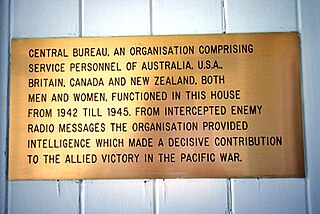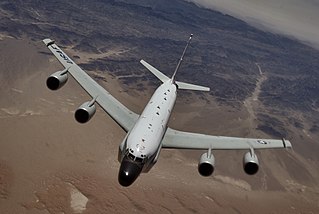Related Research Articles

Signals intelligence (SIGINT) is intelligence-gathering by interception of signals, whether communications between people or from electronic signals not directly used in communication. Signals intelligence is a subset of intelligence collection management. As sensitive information is often encrypted, signals intelligence in turn involves the use of cryptanalysis to decipher the messages. Traffic analysis—the study of who is signaling whom and in what quantity—is also used to integrate information again.

Australian Signals Directorate is the Australian government agency responsible for foreign signals intelligence, support to military operations, cyber warfare, and information security. ASD is part of the Australian Intelligence Community. ASD's role within UKUSA Agreement is to monitor SIGINT in South and East Asia. The ASD also houses the Australian Cyber Security Centre.

The Communications Security Establishment, formerly called the Communications Security Establishment Canada (CSEC), is the Government of Canada's national cryptologic agency. Administered under the Department of National Defence (DND), it is responsible for foreign signals intelligence (SIGINT) and protecting Canadian government electronic information and communication networks. The CSE is accountable to the Minister of National Defence through its deputy head, the Chief of CSE. The Minister of National Defence is in turn accountable to the Cabinet and Parliament. The Agency has recently built a new headquarters and campus encompassing 34 ha. The new headquarters totals a little over 110,000 square metres and is adjacent to CSIS. The Chief of the CSE is currently Shelly Bruce, who assumed the office on June 27, 2018.

Royal Air Force Menwith Hill is a Royal Air Force station near Harrogate, North Yorkshire, England, which provides communications and intelligence support services to the United Kingdom and the United States. The site contains an extensive satellite ground station and is a communications intercept and missile warning site. It has been described as the largest electronic monitoring station in the world.

The Central Security Service (CSS) is an agency of the United States Department of Defense, which was established in 1972 to integrate the National Security Agency (NSA) and the Service Cryptologic Components (SCC) of the United States Armed Forces in the field of signals intelligence, cryptology, and information assurance at the tactical level. In 2002, the CSS had approximately 25,000 uniformed members.

Technical research ships were used by the United States Navy during the 1960s to gather intelligence by monitoring, recording and analyzing wireless electronic communications of nations in various parts of the world. At the time these ships were active, the mission of the ships was covert and discussion of the true mission was prohibited. The mission of the ships was publicly given as conducting research into atmospheric and communications phenomena. However, the true mission was more or less an open secret and the ships were commonly referred to as "spy ships".

DESOTO patrols were patrols conducted by U.S. Navy destroyers equipped with a mobile "van" of signals-intelligence equipment used for intelligence collection in hostile waters. The USS De Haven became the namesake for these patrols. De Haven performed the first patrol off the coast of China in April 1962. The USS Agerholm carried out the first patrol to target North Vietnam in the Gulf of Tonkin in December 1962.

The Central Bureau was one of two Allied Signals intelligence (SIGINT) organisations in the South West Pacific area (SWPA) during World War II. Central Bureau was attached to the Headquarters of the Allied Commander of the South West Pacific area, Douglas MacArthur. Central Bureau's role was to research and decrypt intercepted Imperial Japanese Army traffic and work in close co-operation with other SIGINT centres in the USA, United Kingdom and India. Air activities included both army and navy air forces, as there was no independent Japanese Air Force.

The United States Army Intelligence Support Activity (USAISA), frequently shortened to Intelligence Support Activity or Mission Support Activity, and nicknamed The Activity, the Army of Northern Virginia, or Office of Military Support, is a United States Army Special Operations unit originally subordinated to the US Army Intelligence and Security Command (INSCOM) but now part of the Joint Special Operations Command. It is tasked to collect actionable intelligence in advance of missions by other US special operations forces, especially 1st SFOD-D and DEVGRU in counter-terrorist operations.

The Finnish Defence Intelligence Agency is the combined signals (SIGINT), geospatial (GEOINT) and imagery intelligence (IMINT) agency of the Finnish Defence Forces. Operational since 2014, its responsibility is to support the defence of Finland through information gathering and analysis as an intelligence agency, organic to the Intelligence Division of Defence Command.
Signals intelligence by alliances nations and industries, many organizations, national or not, are responsible for communications security as well as SIGINT; the organization makes codes and ciphers that it hopes opponents cannot break. There is a synergy between the two components; there is a saying among cryptologists that no one is qualified to create a cipher unless they have successfully cryptanalyzed a cipher of equivalent complexity.

Signals intelligence operational platforms are employed by nations to collect signals intelligence, which is intelligence-gathering by interception of signals, whether between people or between machines, or mixtures of the two. As sensitive information is often encrypted, signals intelligence often involves the use of cryptanalysis. However, traffic analysis—the study of who is signalling whom and in what quantity—can often produce valuable information, even when the messages themselves cannot be decrypted.
SIGINT is a contraction of SIGnals INTelligence. Before the development of radar and other electronics techniques, signals intelligence and communications intelligence (COMINT) were essentially synonymous. Sir Francis Walsingham ran a postal interception bureau with some cryptanalytic capability during the reign of Elizabeth I, but the technology was only slightly less advanced than men with shotguns, during World War I, who jammed pigeon post communications and intercepted the messages carried.

Special reconnaissance (SR) is conducted by small units of highly trained military personnel, usually from special forces units or military intelligence organizations, who operate behind enemy lines, avoiding direct combat and detection by the enemy. As a role, SR is distinct from commando operations, but both are often carried out by the same units. The SR role frequently includes covert direction of air and missile attacks, in areas deep behind enemy lines, placement of remotely monitored sensors, and preparations for other special forces. Like other special forces, SR units may also carry out direct action and unconventional warfare, including guerrilla operations.
After the end of World War II, all the Western allies began a rapid drawdown of military forces, including those of signals intelligence. At the time, the US still had a COMINT organization split between the Army and Navy. A 1946 plan listed Russia, China, and a [redacted] country as high-priority targets.

Vint Hill Farms Station (VHFS) was a United States Army and National Security Agency (NSA) signals intelligence and electronic warfare facility located in Fauquier County, Virginia, near Warrenton. VHFS was closed in 1997 and the land was sold off in 1999. Today the site hosts various engineering and technology companies, as well as two Federal Aviation Administration (FAA) air traffic control facilities.

Initially established as the Air Force (USAF) Security Group in June, 1948, the USAF Security Service (USAFSS) was activated as a major command on Oct 20, 1948

The 707th Intelligence, Surveillance and Reconnaissance Group is a unit of the United States Air Force 70th Intelligence, Surveillance and Reconnaissance Wing located at Fort George G. Meade, Maryland.

A SIGINT Activity Designator identifies a signals intelligence (SIGINT) line of collection activity associated with a signals collection station, such as a base or a ship. For example, the SIGAD for Menwith Hill in the UK is USD1000. SIGADs are used by the signals intelligence agencies of the United States, the United Kingdom, Canada, Australia and New Zealand.

German Intercept Station Operations were intercept operations that were undertaken by the German Army forces in Europe during World War II. Interception is the gathering of radio signals as part of a signals intelligence operation.
References
- ↑ "Guide to Cryptologic Acronyms & Abbreviations, 1940-1980". October 2002. p. 27. Retrieved 6 Jul 2013.
- 1 2 3 "Eavesdropping on Hell: Historical Guide to Western Communications Intelligence and the Holocaust, 1939-1945" (PDF). 2005. p. 135. Archived from the original (PDF) on 10 October 2012. Retrieved 6 Jul 2013.
- ↑ Budiansky, Stephen (2016). Code Warriors. New York: Alfred A. Knopf. p. 301. ISBN 9780385352666.